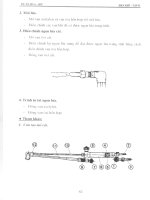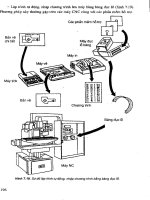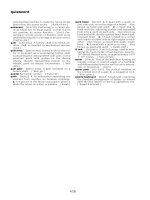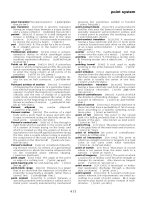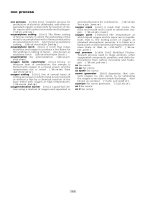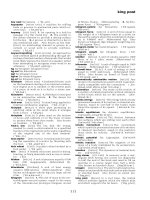Cutting Tools Episode 2 Part 8 potx
Bạn đang xem bản rút gọn của tài liệu. Xem và tải ngay bản đầy đủ của tài liệu tại đây (10.68 MB, 8 trang )
www.toolingandproduction.com
Chapter 17/Tooling & Production
1
2
Tooling & Production/Chapter 17
www.toolingandproduction.com
George Schneider, Jr. CMfgE
Professor Emeritus
Engineering Technology
Lawrence Technological University
Former Chairman
Detroit Chapter ONE
Society of Manufacturing Engineers
Former President
International Excutive Board
Society of Carbide & Tool Engineers
Lawrence Tech www.ltu.edu
Prentice Hall- www.prenhall.com
CHAPTER 17
Grinding Methods
and Machines
Metal Removal
Cutting-Tool Materials
Metal Removal Methods
Machinability of Metals
Single Point Machining
Turning Tools and Operations
Turning Methods and Machines
Grooving and Threading
Shaping and Planing
Hole Making Processes
Drills and Drilling Operations
Drilling Methods and Machines
Boring Operations and Machines
Reaming and Tapping
Multi Point Machining
Milling Cutters and Operations
Milling Methods and Machines
Broaches and Broaching
Saws and Sawing
Abrasive Processes
Grinding Wheels and Operations
Grinding Methods and Machines
Lapping and Honing
Upcoming Chapters
17.2 Grinding Processes
Grinding machines have ad-
vanced in design, construction, ri-
gidity, and application far more in
the last decade than any other
standard machine tool in the
manufacturing industry. Grinding
machines fall into five categories:
* Surface grinders
* Cylindrical grinders
* Centerless grinders
* Internal grinders
* Special types
of grinders.
17.2.1 Surface
Grinding
Surface grind-
ers are used to
produce flat, an-
gular, and irregu-
lar surfaces. A
typical hand op-
erated surface
grinder is shown
in Figure 17.2a.
In the surface
17.1 Introduction
Grinding, or abrasive machining, is one of the most rapidly growing metal
removal processes in manufacturing. Many machining operations previously
done on conventional milling machines, lathes and shapers, are now being
performed on various types of grinding machines. Computer Numerical Control
(CNC) resulting in greater produc-
tivity, improved accuracy, reliabil-
ity, and rigid construction charac-
terize today’s industrial grinding
machines. A typical internal
grinding operation is shown in
Figure 17.1.
FIG. 17.1: Typical internal grinding operation.
(Courtesy Kellenberger, A Hardinge Co.)
grinding process, the grinding wheel
revolves on a spindle and the work-
piece, mounted on either a reciprocat-
ing or rotary table, is brought into
FIG. 17.2: (a) Typical standard surface grinder. (Courtesy Bridge-
port Machine, Inc.) (b) Schematic illustration of the basic compo-
nents and motions of a surface grinder.
www.toolingandproduction.com
Chapter 17/Tooling & Production
3
Chap. 17: Grinding Methods and Machines
contact with the grinding wheel (Fig.
17.2b).
A typical surface grinding operation
is shown in Figure 17.3. Four types of
surface grinders are commonly used in
industry (Fig. 17.4).
Horizontal Spindle/Reciprocating
Table: This surface grinder is the most
commonly used type in industry. A
manual surface grinder was shown in
Figure 17.2a. A more sophisticated and
automated surface grinder is shown in
Figure 17.5. It is available in various
sizes to accommodate large or small
workpieces. With this type of surface
grinder, the work moves back and forth
under the grinding wheel.
The grinding wheel is
mounted on a horizontal
spindle and cuts on its pe-
riphery as it contacts the
workpiece. The worktable
is mounted on a saddle that
provides cross feed move-
ment of the workpiece.
The wheelhead assem-
bly moves vertically on
a column to control the
depth of cut required.
Horizontal Spindle/
Rotary Table: This sur-
face grinder also has a
horizontally mounted grinding
wheel that cuts on its periphery.
The workpiece rotates 360 degrees
on a rotary table underneath the
wheelhead. The wheelhead moves
across the workpiece to provide the
necessary cross feed movements.
The metal removal rate is con-
trolled by the amount of down-feed
of the wheelhead assembly.
Vertical Spindle/ Reciprocating
Table: This type of grinding ma-
chine is particularly suited for
grinding long and narrow castings like
the bedways of an engine lathe. It
removes metal with the face of the
grinder wheel while the work recipro-
cates under the wheel. The wheelhead
assembly, as on most other types of
surface grinders, moves vertically to
control the depth of cut. The table
moving laterally accomplishes cross
feed. The table is mounted on a saddle
unit.
Vertical Spindle/ Rotary Table:
This type of grinding machine (Fig.
17.6) is capable of heavy cuts and high
metal removal rates. Vertical spindle
machines use cup, cylinder, or seg-
mented wheels. Many are equipped
with multiple spindles to successively
rough, semifinish, and finish large
castings, forgings, and welded fabrica-
tions. These grinding machines are
available in various sizes and have up
to 225-HP motors to drive the spindle.
Work Holding Devices: Almost any
work holding device used on a milling
machine or drill press can be used on
surface grinders. Vises, rotary tables,
index centers, and other fixtures are
used for special set-ups. However, the
most common work holding device on
surface grinders is the magnetic chuck.
Magnetic chucks hold the workpiece
by exerting a magnetic attraction on
the part. Only magnetic materials such
as iron and steel may be mounted
directly on the chuck. Two types of
magnetic chucks are available for sur-
face grinders: The permanent magnet
and the electromagnetic chucks. Three
types of magnetic chucks are shown in
Figure 17.7.
On permanent magnet chucks, the
FIG. 17.3: Typical surface grinding operation. (Cour-
tesy Norton Company)
FIG. 17.4: Four types of surface grinders commonly used in industry: (a) horizon-
tal spindle/reciprocating table, (b) horizontal spindle/rotary table, (c) vertical spin-
dle/reciprocating table, (d) vertical spindle/rotary table.
Infeed
Infeed
Infeed
Infeed
Wheel speed
Wheel speed
Wheel speed
Wheel spee
d
Crossfeed
Crossfeed
Workspeed
Workspeed
Workspeed
Workspeed
(a) (b)
(c) (d)
FIG. 17.5: Automated surface grinder with
coolant system. (Courtesy Chevalier Machin-
ery, Inc.)
4
Tooling & Production/Chapter 17
www.toolingandproduction.com
Chap. 17: Grinding Methods and Machines
holding power comes from permanent
magnets. The work is placed onto the
chuck and a hand lever is moved to
energize the magnets. The electromag-
netic chuck operates on 110 or 220
volts and is energized by a switch. This
type of chuck has two advantages.
First, the holding power may be ad-
justed to suit the area of contact of the
workpiece; small amounts of current
are used with smaller parts, large
amounts with larger parts. A second
advantage is the demagnetizer switch.
It reverses the current flow momen-
tarily and neutralizes the residual mag-
netism from the chuck and workpiece.
17.2.2 Cylindrical Grinding
Cylindrical grinding is the process
of grinding the outside surfaces of a
cylinder. These surfaces may be
straight, tapered or contoured. Cylin-
drical grinding operations resemble
lathe turning operations. They replace
the lathe when the workpiece is hard-
ened or when extreme accuracy and
superior finish are required. Figure
17.8 illustrates the basic motion of the
cylindrical grinding machine. As the
workpiece revolves, the grinding
wheel, rotating much faster in the op-
posite direction, is brought into con-
tact with the part. The
workpiece and table re-
ciprocate while in
contact with the grind-
ing wheel to remove
material.
A CNC cylindrical
grinder with a coolant
system is shown in Fig-
ure 17.9; a very large
roll grinder is shown in
Figure 17.10.
Work Holding De-
vices: Work holding
devices and accessories
used on center-type cy-
lindrical grinders are
similar to those used on
engine lathes.
The primary method
of holding work is be-
tween centers as shown
in Figure 17.9. The
points on these centers
may be high-speed
steel or tungsten car-
bide (Fig. 4.12). A lu-
bricant is used with either type and is
applied between the point of the center
and the center hole in the work.
Independent, uni-
versal and collet
chucks can be used on
cylindrical grinders
when the work is odd-
shaped or contains no
center hole. They are
used also for internal
grinding operations.
17.2.3 Centerless Grinding
Centerless grinding machines elimi-
nate the need to have center holes for
the work or to use work-holding de-
vices. In centerless grinding, the work-
piece rests on a workrest blade and is
backed up by a second wheel, called
the regulating wheel (Fig. 17.11). The
rotation of the grinding wheel pushes
the workpiece down on the workrest
blade and against the regulating wheel.
The regulating wheel, usually made of
a rubber bonded abrasive, rotates in
the same direction as the grinding
wheel and controls the longitudinal
feed of the work when set at a slight
angle. By changing this angle and the
speed of the wheel, the workpiece feed
rate can be changed. The diameter of
the workpiece is controlled by two
factors: The distance between the
grinding wheel and regulating wheel,
and by changing the height of the
workrest blade.
A typical centerless grinding opera-
FIG. 17.6: Vertical-spindle grinder with
rotary table. (Courtesy WMW Machin-
ery Co. Inc.)
FIG. 17.7: Three magnetic chucks: (a) electromagnetic
chuck, (b) permanent magnet chuck, (c) rotary electro-
magnetic chuck.
FIG.17.8: Schematic illustration of the basic components and motions of a cylin-
drical grinder.
FIG. 17.9: CNC cylindrical grinder with coolant system.
(Courtesy K. O. Lee Co.)
FIG. 17.10: Very large computer controlled roll grinder
(Courtesy: WMW Machinery Co. Inc.)
www.toolingandproduction.com
Chapter 17/Tooling & Production
5
Chap. 17: Grinding Methods and Machines
tion is shown in Figure 17.12 and
centerless grinder is shown in Figure
17.13.
17.2.4 Internal Grinding
Internal grinders are used to accu-
rately finish straight, tapered, or
formed holes. The most popular inter-
nal grinder is similar in operation to a
boring operation in a lathe. The work-
piece is held by a work holding device,
usually a chuck or collet, and revolved
by a motorized headstock. A separate
motor head in the same direction as the
workpiece revolves the grinding
wheel. It can be fed in and out of the
work and also adjusted for depth of
cut. An internal grinding operation
with a steady rest is shown in Figure
17.14.
17.2.5 Special Grinding Processes
Special types of grinders are grind-
ing machines made for specific types
of work and operations. A brief de-
scription of the more com-
monly used special types
follows:
Tool and Cutter Grinders: A tool
and cutter grinder was introduced in
Chapter 8 - Drilling Operations (Fig.
8.12). These grinding machines are
designed to sharpen milling cutters,
reamers, taps, and other machine tool
cutters. A tabletop tool and cutter
grinder is shown in Figure 17.15 and a
5-axis CNC cutter grinder is shown in
Figure 17.16.
The general purpose cutter grinder
is the most popular and versatile tool
grinding machine. Various attachments
are available for sharpening most types
of cutting tools. Sharpening of a tap is
shown in Fig. 17.17a and grinding of a
milling cutter is shown in Fig. 17.17b.
Figure 17.18 shows sharpening of a
carbide milling
cutter with a dia-
mond cup-grind-
ing wheel.
FIG. 17.12: Typical centerless grinding operation. (Cour-
tesy Cincinnati Machine)
Jig Grinding Machines: Jig grind-
ers were developed to locate and accu-
rately grind tapered or straight holes.
Jig grinders are equipped with a high
speed vertical spindle for holding and
driving the grinding wheel. They uti-
lize the same precision locating system
as do jig borers. A 5-axis continuous
path jig grinder is shown in Figure
17.19.
Thread Grinding Machines: These
are special grinders that resemble the
cylindrical grinder. They must have a
precision lead screw to produce the
correct pitch, or lead, on a threaded
part. Thread grinding machines also
have a means of dressing or truing the
cutting periphery of the grinding
FIG. 17.14: Internal grinding operation; the work-
piece is held by a collet and supported in a steady-
rest. (Courtesy kellenberger, A Hardinge Co.)
FIG. 17.13: A Centerless Grinder is shown
Courtesy: Cincinnati Machine)
FIG. 17.11: Operating principle of a centerless grinder.
Grinding
wheel
Workpiece
Regulating
wheel
Work
rest
blade
6
Tooling & Production/Chapter 17
www.toolingandproduction.com
Chap. 17: Grinding Methods and Machines
wheel so that it will produce a precise
thread form on the part. Figure 17.20
shows a CNC thread grinder with a
robotic loading system and menu-
driven software programs.
17.3 Creep-Feed Grinding
Grinding has traditionally been asso-
ciated with small rates of metal removal
and fine finishing operations. However,
grinding can also be used for large-scale
metal removal operations similar to mill-
ing, broaching, and planning. In creep-
feed grinding, developed in the late
1950’s, the wheel depth of cut is as much
as 0.25 in., and the workpiece speed is
low. The wheels are mostly softer grade
resin bonded with open
structures to keep tempera-
tures low and improve sur-
face finish. The machines
used for creep-feed grind-
ing have special features,
such as high power – up to
300hp – high stiffness,
high damping capacity,
variable spindle and work-
table speeds, and ample
capacity for grinding flu-
ids.
Its overall competitive
position with other mate-
rial-removal processes in-
dicate that creep-feed
grinding can be economi-
cal for specific applica-
tions, such as in grinding
shaped punches, twist-
drill flutes, and various
complex super alloy
parts. The wheel is dressed to the
shape of the workpiece to be produced.
Consequently, the workpiece does not
have to be previously
milled, shaped, or
broached. Thus near-net
shape castings and
forgings are suitable
parts for creep-feed
grinding. Although gen-
erally one pass is suffi-
cient, a second pass may
be necessary for im-
proved surface finish.
17.4 Grinding Wheel
Wear
The wear of a grinding
wheel can be caused by
three actions:
* Attrition or wearing
down
* Shattering of the
grains
* Breaking of the bond
In most grinding processes, all three
mechanisms are active to some extent.
Attritions war is not desirable because
the dulled grains reduce the efficiency
of the process, resulting in increased
power consumption, higher surface
temperatures, and surface damage.
However, attrition must go on to some
extent, with the forces on the grit
being increased until they are high
enough to shatter the grit or break the
bond posts holding the dulled grit. The
action of particles breaking away from
the grains serves to keep the wheel
sharp without excessive wear. How-
ever, the grains must eventually
break from the bond or the wheel
will have to be dressed. Rupturing
the bond post that holds the grit
allows dull grains to be sloughed off,
exposing new sharp edges. If this
occurs too readily, the wheel diam-
eter wears down too fast. This raises
wheel costs and prohibits close
sizing on consecutive parts.
G-ratio: The G-ratio is the ratio of
the amount of stock removed verses
the amount of wear on the wheel,
measured in cubic inches per minute.
This ratio will vary from 1.0 to 5.0 in
very rough grinding and up to 25.0 to
FIG. 17.17: Tool and cutter grinder setups: (a) sharpening of a tap, (b) sharpening
of a milling cutter. (Courtesy K. O. Lee Co.)
FIG. 17.16: 5-axis CNC cutter grinder. (Courtesy: Star
Cutter Co.)
FIG. 17.18 Sharpening of a carbide
milling cutter with a diamond cup
grinding wheel. (Courtesy Norton
Company)
FIG. 17.15: Table top tool and cutter grinder is shown
sharpening an end milling cutter. (Courtesy Chevalier
Machinery, Inc.)
www.toolingandproduction.com
Chapter 17/Tooling & Production
7
Chap. 17: Grinding Methods and Machines
50.0 in finish grinding.
Even though grinding
wheels are fairly expensive, a
high G-ratio is not necessarily
economical, as this may mean
a slower rate of stock removal.
It often takes some experiment-
ing to find the wheel-metal
combination, which is most
economical for a job.
17.4.1 Attritions Wear
Attritions wear is respon-
sible for the so-called ‘glazed’
wheel, which occurs when flat
areas are worn on the abrasive
grains but the forces are not
high enough to break the dull
grains out of the wheel face.
Effective grinding ceases with
a glazed wheel when the radial
force becomes so high that the
grit can no longer penetrate
the workpiece surface to form
chips. Attritions wear of the wheel
occurs most often when fine cuts are
taken on hard abrasive materials. Tak-
ing heavier cuts or using a softer wheel
that will allow the grains to break out
can often avoid it.
17.4.2 Grain Fracture
The forces that cause the grain to
shatter may arise from the cutting
forces acting on the wheel, thermal
conditions, shock loading, welding ac-
tion between the grit and the chip, or
combinations of these factors. In finish
grinding, this type of wheel wear is
desirable, because it keeps
sharp edges exposed, and
still results in a low rate of
wheel wear. In time, the
wheel may become
‘loaded’ and noisy, and re-
quire dressing. A loaded
wheel should be dressed by
taking a few deep cuts with
the diamond so that the
metal charged layer is re-
moved, and the chips are
not just pushed further into
the wheel. Then it should
be finish dressed according
to the application require-
ments.
17.4.3 Bond Fracture
It is desirable to have
worn grit break out of the
wheel so that new cutting edges will
be exposed. This breaking down of
the bond should progress fast enough
so that heat generation is sufficiently
low to avoid surface damage. On the
other hand, bond breakdown should
be slow enough so that wheel costs
are not prohibitive. Normally, this
means choosing the proper wheel
grade for the job. Certain bond hard-
ness is required to hold the grain in
place. Softer wheels crumble too
fast, while harder wheels hold the
dull grit too long.
FIG. 17.19: Continuous path 5-axis jig grinder. (Courtesy
Moore Tool Co., Inc.)
17.5 Coated Abrasives
Typical examples of coated
abrasives are sandpaper and
emery cloth. The grains used
in coated abrasives are more
pointed than those used for
grinding wheels. The grains
are electrostatically deposited
on flexible backing material,
such as paper or cloth. The
matrix or coating is made of
resin.
Coated abrasives are avail-
able as sheets, belts, and disks
and usually have a much more
open structure than the abra-
sives on grinding wheels.
Coated abrasives are used ex-
tensively in finishing flat or
curved surfaces of metallic or
nonmetallic parts, and in
woodworking. The surface fin-
ishes obtained depend prima-
rily on the grain sizes.
17.5.1 Abrasive Belt Machining
Coated abrasives are also used as
belts for high-rate material removal.
Belt grinding has become an important
production process, in some cases re-
placing conventional grinding opera-
tions such as the grinding of cam-
shafts. Belt speeds are usually in the
range of 2500 to 6000 ft/min. Ma-
chines for abrasive-belt operations re-
quire proper belt support and rigid
construction to minimize vibration.
Figure 17.21 shows a multi-axis CNC
double-station belt-grinding machine
with menu-driven canned
software programs.
17.6 Grindability
Grindability, in a like
manner as machinability,
may be thought of as the
ease with which material
can be removed from the
workpiece by the action of
the grinding wheel. Surface
finish, power consumption,
and tool (wheel) life can be
considered as fundamental
criteria of the grindability
of metals. In addition, there
are the important factors of
chip formation and suscep-
tibility to damage of the
workpiece. Chip formation,
which leads to a ‘loaded’
FIG. 17.20: CNC Thread Grinder with a robotic loading system
(Courtesy: Drake Manufacturing Services)
8
Tooling & Production/Chapter 17
www.toolingandproduction.com
Chap. 17: Grinding Methods and Machines
FIG.17.21 CNC double-station Belt Grinding Machine
(Courtesy: Drake Manufacturing Services)
wheel, is detrimental.
The most important
machine setting affecting
machinability, the cutting
speed, is not as important
an influence on
grindability because
grinding is done at more
or less constant speed. In-
stead, the important fac-
tor becomes the nature of
the grinding wheel. The
type of grit, grit size,
bond material, hardness,
and structure of the
wheel, all influence the
grindability of the work-
piece. The problems of
tool material and con-
figuration variables were discussed in
connection with machinability.
In grinding operations like snagging
and cut-off work, the surface finish,
and even the metallurgical damage to
the workpiece, may become relatively
unimportant. Wheel life and the rate of
cut obtainable then become the criteria
of grindability.
The best way to determine
grindability is to start with the selec-
tion of the proper wheel. Beginning
with the manufacturer’s recommended
grade for the conditions of the job, and
then trying wheels on each side of this
grade do this. Any improvement or
deterioration in the grinding action, as
evidenced by wheel wear, surface fin-
ish, or damage to the workpiece, can
be noted. After the proper wheel has
been chosen, wheel life data may be
obtained. Usually, this can be done
during a production run.
Some of the factors to consider in
establishing grindability ratings are
discussed in the following examples of
the grinding performance of metals:
Cemented Carbide: This material
cannot be ground with aluminum oxide
grit wheels. Although cemented carbide
can be ground with pure silicon carbide
wheels, the grinding ratio is very low
and the material is easily damaged.
Carbide is easily ground with diamond
wheels if light cuts are taken to prevent
damage to the workpiece material.
However, diamond grit wheels are quite
expensive. The overall grindability of
this material is very low.
High Speed Steel: Hard-
ened high speed steel can be
ground quite successfully
with aluminum oxide grit
wheels. The grinding ratio is
low, the relative power con-
sumption high, and the pos-
sibility of damage to the
workpiece is always present.
Overall grindability is quite
low.
Hardened Steel: Medium
hard alloy or plain carbon
steels are easily ground with
aluminum oxide wheels.
The grinding ratio is good,
and damage to the work-
piece is not a serious prob-
lem. Relative power con-
sumption is moderate. The grindability
rating is good.
Soft Steel: Annealed plain carbon
steels grind with relatively low power
consumption. Aluminum oxide wheels
are satisfactory. The grinding ratio is
quite high, but surface damage may be
encountered. As a group, these materi-
als are rated as having good
grindability.
Aluminum Alloys: These soft alloys
grind with quite low power consump-
tion, but they tend to load the wheel
quickly. Wheels with a very open
structure are needed. Grinding ratios
are good. Silicon carbide grit works
well, and belt grinding outperforms
wheel grinding in many cases.
